
|
Table of Contents |
|
Comet Introduction
|
|
Comets |
|
Shoemaker-Levy 9
|
|
Comet Information |
Comet structures are diverse and very dynamic, but they all develop a surrounding cloud of diffuse material, called a coma, that usually grows in size and brightness as the comet approaches the Sun. Usually a small, bright nucleus (less than 10 km in diameter) is visible in the middle of the coma. The coma and the nucleus together constitute the head of the comet.
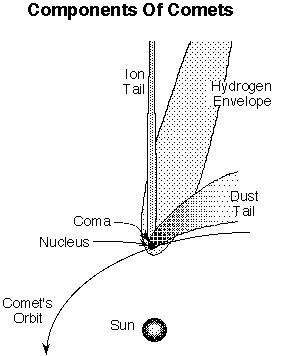 |
|---|
As comets approach the Sun they develop enormous tails of luminous material that extend for millions of kilometers from the head, away from the Sun. When far from the Sun, the nucleus is very cold and its material is frozen solid within the nucleus. In this state comets are sometimes referred to as a "dirty iceberg" or "dirty snowball," since over half of their material is ice. When a comet approaches within a few AU of the Sun, the surface of the nucleus begins to warm, and volatiles evaporate. The evaporated molecules boil off and carry small solid particles with them, forming the comet's coma of gas and dust.
When the nucleus is frozen, it can be seen only by reflected sunlight. However, when a coma develops, dust reflects still more sunlight, and gas in the coma absorbs ultraviolet radiation and begins to fluoresce. At about 5 AU from the Sun, fluorescence usually becomes more intense than reflected light.
As the comet absorbs ultraviolet light, chemical processes release hydrogen, which escapes the comet's gravity, and forms a hydrogen envelope. This envelope cannot be seen from Earth because its light is absorbed by our atmosphere, but it has been detected by spacecraft.
The Sun's radiation pressure and solar wind accelerate materials away from the comet's head at differing velocities according to the size and mass of the materials. Thus, relatively massive dust tails are accelerated slowly and tend to be curved. The ion tail is much less massive, and is accelerated so greatly that it appears as a nearly straight line extending away from the comet opposite the Sun. The following view of Comet West shows two distinct tails. The thin blue plasma tail is made up of gases and the broad white tail is made up of microscopic dust particles.

Comet West
Each time a comet visits the Sun, it loses some of its volatiles. Eventually, it becomes just another rocky mass in the solar system. For this reason, comets are said to be short-lived, on a cosmological time scale. Many scientists believe that some asteroids are extinct comet nuclei, comets that have lost all of their volatiles.
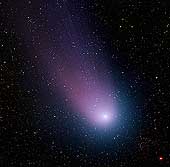 Comet Neat
Comet Neat
This image of comet C/2001 Q4 (NEAT) was taken at the WIYN 0.9-meter
telescope at Kitt Peak National Observatory near Tucson,
Arizona, on May 7, 2004.
The image was captured with the Mosaic I camera, which has a one-square
degree field of view, or about five times the size of the Moon. Even
with this large field, only the comet's coma and the inner portion of
its tail are visible. A small star cluster (C0736-105, or Melotte 72)
is visible in the lower right of the image, between the head of the
comet and the bright red star in the lower-right corner.
(Courtesy NASA, NOAO, NSF, STScI)
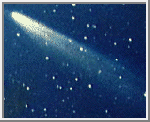 Comet Kohoutek
Comet Kohoutek
This color photograph of the comet Kohoutek was taken by members of the
lunar and planetary laboratory photographic team from the University of
Arizona. They photographed the comet from the Catalina observatory with
a 35mm camera on January 11, 1974. (Courtesy NASA)
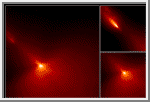 Comet Hyakutake
Comet Hyakutake
These Hubble Space Telescope images of comet Hyakutake were taken on
March 25, 1996 when the comet passed at a distance of 9.3 million miles
from Earth. These images focus on a very small
region near the heart of the comet, the icy, solid nucleus and provide
an exceptionally clear view of the near-nucleus region of the comet.
The left image is 2070 miles across (3340 km) and shows that most of the dust is being produced on the sunward-facing hemisphere of the comet. Also at upper left are three small pieces which have broken off the comet and are forming their own tails. Icy regions on the nucleus are activated as they rotate into sunlight, ejecting large amounts of dust in the jets that are faintly visible in this image. Sunlight striking this dust eventually turns it around and "blows" it into the tailward hemisphere.
The bottom-right image is an expanded view of the near-nucleus region
and is only 470 miles (760
km) across. The nucleus is near the center of the frame, but the
brightest area is probably the tip of the strongest dust jet rather
than the nucleus itself. Presumably, the nucleus surface lies just
below this bright jet.
The top-right image shows pieces of the nucleus that apparently broke off.
The image shows at least three separate objects that are probably
made up of coarse-grained dust. Large fragments of the nucleus would
not be accelerated into the tail, which appears to be the case in this
image.
(Credit: H. A. Weaver--Applied Research Corp.,
HST Comet Hyakutake Observing Team, and NASA)
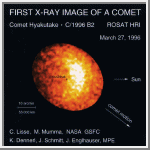 First X-Rays From Comet Hyakutake Discovered
First X-Rays From Comet Hyakutake Discovered
This image shows the discovery of a strong X-ray radiation signal
coming from comet Hyakutake. The image was made on March 27, 1996
using Germany's orbiting ROSAT satellite. The comet was near its
closest approach to the Earth at a distance of less than 10 million
miles when X-ray emmisions were first detected by ROSAT.
The strength and rapid changes in intensity of the comet's X-ray
emission both surprised and puzzled astronomers.
"We had no clear expectation that comets shine in X-rays,"
said Dr. Michael J. Mumma of NASA's Goddard Space Flight Center,
Greenbelt, MD. X-rays have never been found from a comet before, and
scientists had optimistically predicted an intensity that
turned out to be about 100 times weaker than the radiation
actually detected by ROSAT. Strong changes in the
brightness of the X-rays were another surprise. There were
pronounced increases and decreases in the X-ray brightness
from one ROSAT observation to another, typically over a time
difference of a few hours.
Still another puzzle is the nature of the physical
process that generates the X-rays, but the ROSAT image may
contain clues to this process. In the image, the X-rays
from the comet seem to come from a crescent-shaped region on
the sunward side of Comet Hyakutake. One preliminary
theory is that X-ray emission from the Sun was absorbed by a
cloud of gaseous water molecules surrounding the nucleus of
the comet, and then were re-emitted by the molecules in a
process physicists call "fluorescence."
According to this idea, the cloud is so thick that its
sunward side absorbs nearly all the incoming solar X-rays,
so that none reach the remainder of the cloud. This could
explain why the cometary X-ray emission has the form of a
crescent, rather than that of a sphere around the nucleus.
A second possible explanation is that the X-rays are
produced from the violent collision between the comet
material and the supersonic "wind" of plasma and particles
streaming away from the Sun.
 Comet 1993a Mueller
Comet 1993a Mueller
This is a CCD image of comet 1993a Mueller, taken on October 6, 1993
with a 288mm f/5.2 Schmidt-Cassegrain telescope. The comet has a coma
diameter of 3' and a fan-shaped tail, up to 7' long.
(Courtesy Erich Meyer and Herbert Raab, Austria)
 Comet West (1975)
Comet West (1975)
This photograph was taken by amateur astronomer John Loborde on
March 9, 1976. This picture shows two distinct tails. The
thin blue plasma
tail is made up of gases and the broad white tail is made
up of microscopic dust particles.
(Courtesy John Laborde)
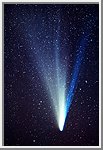 Comet West (1975)
Comet West (1975)
This image of comet West was taken by John Laborde at the
Tierra Del Sol Observatory site in San Diego County.
The exposure was 30 minutes with a 135 mm Nikon lens.
(Courtesy John Laborde)
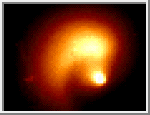 Comet Hale-Bopp
Comet Hale-Bopp
These NASA Hubble Space Telescope pictures of comet Hale-Bopp show a
remarkable "pinwheel" pattern and a blob of free-flying debris near the
nucleus. The bright clump of light along the spiral (above the
nucleus, which is near the center of the frame) may be a piece of the
comet's icy crust that was ejected into space by a combination of ice
evaporation and the comet's rotation, and which then disintegrated into
a bright cloud of particles.
Although the "blob" is about 3.5 times fainter than the brightest
portion at the nucleus, the lump appears brighter because it covers a
larger area. The debris follows a spiral pattern outward because the
solid nucleus is rotating like a lawn sprinkler, completing a single
rotation about once per week.
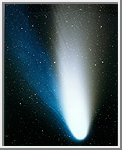 Comet Hale-Bopp
Comet Hale-Bopp
This image of comet Hale-Bopp was taken by John Laborde with his
home designed and built, 8.8" f/3.7 Wright Schmidt Camera.
The picture was taken at the Tierra Del Sol Observatory site in San
Diego County with a 25 minute exposure on Kodak PPF400 film.
(Courtesy John Laborde)
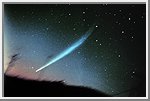 Comet Ikeya-Seki
Comet Ikeya-Seki
This image of comet Ikeya-Seki was taken by John Laborde in
Poway, California just before dawn. The exposure was 15 minutes with
a 55 mm Nikon lens.
(Courtesy John Laborde)

 Asteroids
Asteroids Meteorites
Meteorites